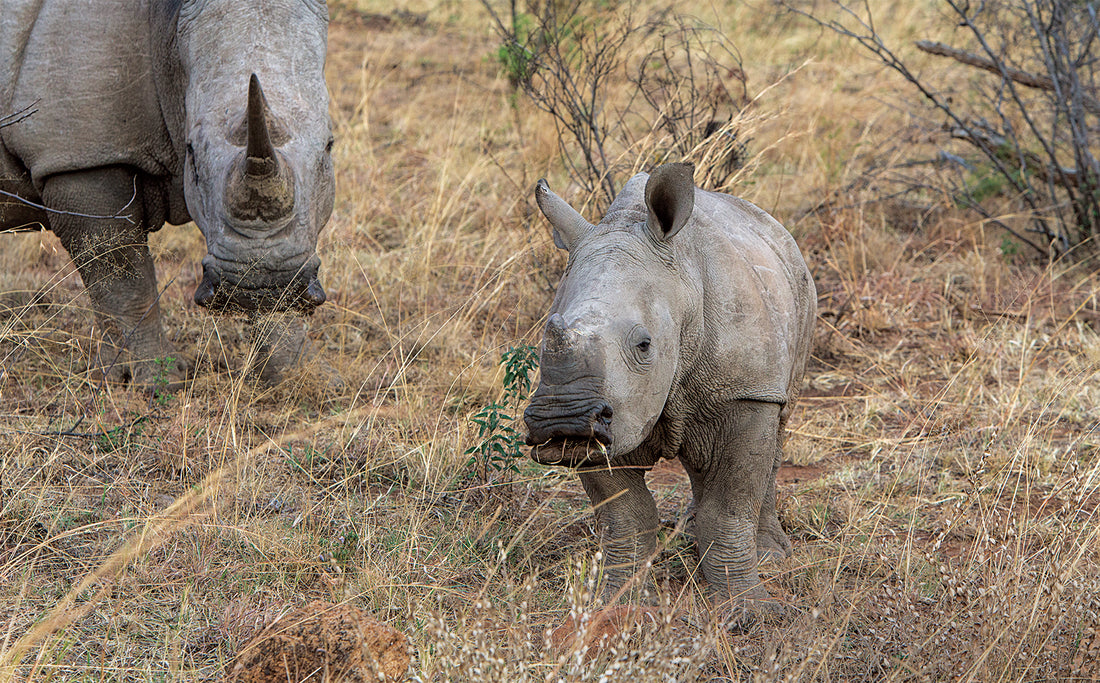Poachers are fearless and ruthless – well-trained and bush-wise. Fences are not enough to stop them, especially on moonlit nights when they move with determination and purpose. They easily dodge the anti-poaching units and predators. The silencers on their guns make it easy to mostly shoot unnoticed. A rhino cow with a calf may be a slight complication but unless the juvenile’s horn is big enough to be of use, they don’t waste ammunition on it. The calf will usually run away but will soon return to its mother. If it interferes while they are removing the mother’s horn, they will simply scare it away by slashing it with a panga or an axe. They work swiftly and remove the horn in no time, before running off.
For the calf, the trauma has only just begun. Initially, it may be scared away but it will return to its mother, not understanding why she does not respond to its cries. It will nudge her teats for milk, shove her with its nose for a response and even if there is none, it will stay there. Not knowing how to graze, a calf then often eats sand to appease its hunger. When that happens, it may be the beginning of the end. Wandering off, or scared away while crying for its mother, it will attract predators.
In the bush a kill does not go unnoticed. Soon the scavengers will arrive. Lions are the biggest threat. Should they be in the vicinity, they will certainly go to investigate. Rhino instinct will urge the calf to escape but the lions’ hunting instinct is equally strong. Even with a mountain of meat right in front of them, they will usually go for the calf.
The Rhino Protection Unit (RPU) works tirelessly behind the scenes. Trying to outsmart poachers is a dangerous job. Their successes and a firm belief in the cause of saving the rhino from extinction keep them going. But it is a continuous struggle, hazardous and extremely expensive. Using a Bat Hawk (a light sports aircraft utilised by most South African parks), the RPU checks rhino activity first thing in the morning. If they find a carcass, they try to establish whether the dead rhino had a calf and if so, they act swiftly to locate it.

A rhino calf rescue is a heart-wrenching, complicated and expensive operation, involving a good number of people. First and foremost is the wildlife vet who flies with the helicopter pilot in search of the small rhino. Once it is found, they have to herd it in the direction of where the rescue trailer is parked. Only the wildlife vet is qualified to decide the correct dosage of the tranquilliser by judging the mass and age of the calf. Too much or too little could be disastrous. He also has to be an excellent marksman, firing the dart at exactly the right time and getting it into a suitable spot on the panic-stricken youngster’s body.
The pilot must be able to come down low and gently herd the baby in the right direction, close to a road where the rest of the team is waiting. Once the calf is close enough to be captured manually, the helicopter needs to find a spot nearby to land so the vet can jump out immediately to inject the antidote. All this is traumatic for the animal and the blindfold and ear plugs used help reduce stimulation for the calf and to calm it. Of course, the animal has no idea the humans who now surround it are there to rescue it.

The ground crew also have to be on the ball. Even very young rhino calves are amazingly strong. The driver has to be ready to get the truck with the closed trailer in the correct position for easy loading. Once the calf is inside, the makeshift blindfold is replaced with a more protective one to prevent its eyes from being injured.
Rhino babies that are orphaned because the mother was killed by poachers seldom survive unless they are rescued. Many succumb to predation and starvation, especially if they are less than a year old. A few lucky ones may be rescued in time, but unless they are taken to a rehabilitation centre that specialises in hand-rearing them, their chances of survival are still slim. They need proper treatment, nutrition, care and a lot of love.
The Pilanesberg Game Reserve takes its rhino orphans to The Rhino Orphanage, which is the world’s first non-profit organisation dedicated exclusively to the care and rehabilitation of rhino calves orphaned by poaching.
- Taken from Pilanesberg Self-Drive

